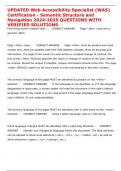UPDATED Web Accessibility Specialist (WAS)
Certification - Semantic Structure and
Navigation 2024-2025 QUESTIONS WITH
VERIFIED SOLUTIONS
First thing screen readers hear: - CORRECT ANSWER Page <title> (also this is
good for SEO)
Page <title> rules: - CORRECT ANSWER Page <title> must be present and must
contain text. Must be updated when the web address changes. Must be accurate and
informative. If a page is the result of a user action or scripted change of context, the
text of the <title> SHOULD describe the result or change of context to the user. Should
be concise. Should be unique if possible. Unique information should come first. The page
<title> SHOULD match (or be very similar to) the top heading in the main content.
The primary language of the page MUST be identified accurately on the <html>
element. - CORRECT ANSWER If the language is not specified, or if it the language
designation is inaccurate, a screen reader will read the document in the user's default
language, which may result in a very bad accent if the page language doesn't match the
user's default. Or not understandable.
The primary language of the page MUST be identified with a valid value on the <html>
element. - CORRECT ANSWER Using 2 letter language code or LCID string.
Inline language changes MUST be identified with a valid lang attribute. - CORRECT
ANSWER Identify any changes of language within the document. The lang attribute
can be applied to block level elements (<div>, <h1>, <p>, <table>, etc.) as well as
inline elements (<span>, <a>, <strong>, etc.).
,UPDATED Web Accessibility Specialist (WAS)
Certification - Semantic Structure and
Navigation 2024-2025 QUESTIONS WITH
VERIFIED SOLUTIONS
Example:
<p>While in Spain, my friend tried to speak Spanish,
but she wasn't very good. Everyone kept saying
"<span lang="es">No comprendo nada de lo que dices.</span>"</p>
Landmarks SHOULD be used to designate pre-defined parts of the layout (<header>,
<nav>, <main>, <footer>, etc.). - CORRECT ANSWER Use either HTML 5
landmarks or their ARIA equivalents to mark sections of the layout in the design, so that
screen reader users can easily find their way around the layout.
Landmarks are used to designate sections of the overall page design and layout.
Headings are used to designate sections within the content.
All text SHOULD be contained within a landmark region. - CORRECT ANSWER
Labels for headers, mains, sections, articles, asides, footers, etc. Using just <div> isn't
enough.
Multiple instances of the same type of landmark SHOULD be distinguishable by different
discernible labels (aria-label or aria-labelledby). - CORRECT ANSWER Example:
<nav aria-label="Corporate and legal info">
A page SHOULD NOT contain more than one instance of each of the following
landmarks: banner, main, and contentinfo. - CORRECT ANSWER The ARIA
, UPDATED Web Accessibility Specialist (WAS)
Certification - Semantic Structure and
Navigation 2024-2025 QUESTIONS WITH
VERIFIED SOLUTIONS
specification states that the landmarks role="banner", role="main", and
role="contentinfo" are meant to be used only once per page. Other ARIA landmarks can
be used multiple times. Interestingly, the HMTL 5 specification allows multiple instances
of the equivalent landmarks: <header>, <main>, and <footer>. The official restriction
is only on ARIA landmarks. Even so, it is appropriate in most web designs to have only
one each of these landmarks, whether they are specified using ARIA or HTML 5.
The total number of landmarks SHOULD be minimized to the extent appropriate for the
content. - CORRECT ANSWER One of the main purposes of landmarks is to allow
blind users to quickly find and navigate to the appropriate landmark, so you should keep
the total number of landmarks relatively low. If you don't, screen reader users will have
to sort through too much extra information to find what they're looking for.
Landmarks SHOULD be made backward compatible. - CORRECT ANSWER
Text that acts as a heading visually or structurally SHOULD be designated as a true
heading in the markup. - CORRECT ANSWER Headings are about logical structure,
not visual effects. Big bold text may look like a heading to visual users, but screen
readers ignore the size and font-weight of the text, so blind users cannot know a phrase
is a heading unless it is marked up in the HTML code as such, using <h1>, <h2>, <h3>,
<h4>, <h5>, or <h6>.
Text that does not act as a heading visually or structurally SHOULD NOT be marked as a
heading. - CORRECT ANSWER If you want to create big, bold text for non-heading
text, use styles to achieve that effect. If you use heading markup (<h1>, <h2>, etc.)




